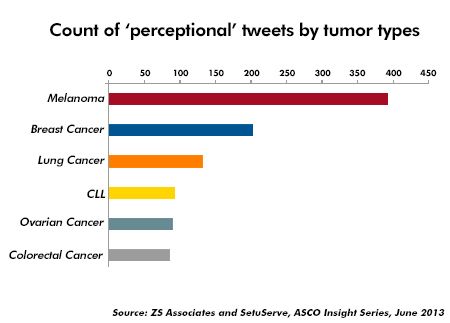Five Ways for Pharma to Read Between the Tweets
While buzz on Twitter will never outweigh critical data in a peer-reviewed publication, social media is becoming an important part of our industry’s dialogue. The oncology market is no exception, as insight gleaned from recent Twitter traffic and trends reveals.
While buzz on Twitter will never outweigh critical data in a peer-reviewed publication, social media is becoming an important part of our industry’s dialogue. The oncology market is no exception, as insight gleaned from recent Twitter traffic and trends reveals.
At the 2013 meeting of the American Society of Clinical Oncology (ASCO), our ZS oncology team attempted to research social media’s impact in real time. ASCO is perhaps the most critical research update and networking event in oncology, with more than 30,000 clinicians, researchers and industry executives attending. At a gathering this big, what’s said away from the podium is also intriguing.
So we partnered with SetuServ to use advanced algorithms, clustering techniques and banding classifications to make sense of dispersed social media data, specifically Twitter updates posted from the conference.
Of special interest were tweets that conveyed an attendee’s perception of a particular study or treatment. Here are five takeaways:
1. Think positive: Upbeat perceptions are, by far, the dominant trend on Twitter. People like to talk about good news and exciting breakthroughs, and are less likely to tweet about a massive drug failure. By contrast, incremental improvements fail to impress or make the Twitterverse.
2. Heed the skeptics: It’s certainly instructive, however, to look at neutral or skeptical messages. Even with exciting clinical news, tweets conveying concerns about cost, drug tolerability, or trial design may foreshadow controversy to come.
One clear example was the reaction to new treatments for metastatic melanoma. Combination therapy was the hot topic here, with new data on BRAF-targeted regimens and immunotherapy combos generating lots of ASCO Tweets. Yet physicians active on Twitter also expressed fears about the high cost of these dual regimens, as well as reservations about long-term tolerability that might limit prime-time use.
3. Follow up offline: When you dig deeper into the 2013 ASCO talk on Twitter, you can see there was also a lot of excitement around new therapies that stimulate the body’s own immune system to fight cancer. So when I talk to pharma company execs, I ask them how they’re going to position their targeted drug portfolios for use with new immunotherapy agents, so that these drugs can be used together or sequentially to achieve the best patient outcomes.
4. Build an argument: In contrast to new breakthrough drugs in melanoma, we saw that incremental data presented in lung cancer about second- and third-generation therapies didn’t always resonate with conference-goers. You can see this just by comparing the volume of tweets generated on each of these disease topics. (See illustration below). One interpretation is that pharma companies are going to have to build an argument to motivate physicians to value these modest, but statistically meaningful, improvements in lung cancer therapies.

5. Target an audience: What’s most important to remember is that there are different audiences engaging in dialogue on Twitter and beyond. So companies need to ask what’s the best home (personal promotion, digital promotion, etc.) for sharing particular kinds of information. As we as an industry become more experienced interpreting social media data, we’ll be able to determine the ideal channels to communicate with customers.
We think analyzing Twitter feeds has a lot of value, and ZS is planning to introduce a more sophisticated model leveraging physician “buzz” at the upcoming American Society of Hematology meeting in December. Social media’s influence will only grow-so as an industry, our engagement level has to keep growing, too.
Addressing Disparities in Psoriasis Trials: Takeda's Strategies for Inclusivity in Clinical Research
April 14th 2025LaShell Robinson, Head of Global Feasibility and Trial Equity at Takeda, speaks about the company's strategies to engage patients in underrepresented populations in its phase III psoriasis trials.
Beyond the Prescription: Pharma's Role in Digital Health Conversations
April 1st 2025Join us for an insightful conversation with Jennifer Harakal, Head of Regulatory Affairs at Canopy Life Sciences, as we unpack the evolving intersection of social media and healthcare decisions. Discover how pharmaceutical companies can navigate regulatory challenges while meaningfully engaging with consumers in digital spaces. Jennifer shares expert strategies for responsible marketing, working with influencers, and creating educational content that bridges the gap between patients and healthcare providers. A must-listen for pharma marketers looking to build trust and compliance in today's social media landscape.